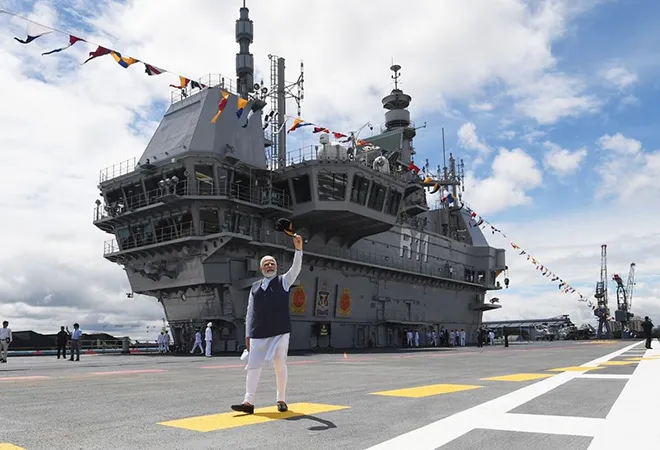
The commissioning of the INS Vikrant is a signal achievement for India and the Indian Navy. Developed by the navy’s Warship Design Bureau and constructed by the Cochin Shipyard Limited (CSL), the Vikrant is India’s largest and most complex
indigenously built warship. With a displacement of 43,000 tonnes, the ship boasts an endurance of about 7,500 nautical miles and a top speed of 28 knots (significant for its size and tonnage). The ship’s integral fleet of MiG 29-K aircraft, Kamov 31 early warning and MH-60R multi-role helicopters, as also state-of-the-art shipboard offence and defence systems, surveillance and fire-control radars, make it a formidable warfighting platform.
Vikrant’s induction, however, has stoked an old debate amongst strategic experts and observers about the relevance of aircraft carriers in the contemporary world. After the Indian Navy’s top brass
reiterated the need for a third aircraft carrier to protect Indian interests in the Indian Ocean, some commentators criticised the move, calling for a mindset change in the navy.
Sceptics say there is little point in spending billions for a carrier strike force to protect the Bay of Bengal or the Arabian Sea when the near-seas defence can be easily ensured from airbases on India’s island territories. Aircraft carriers, the critics posit, are logistically unviable, and highly vulnerable to new
hypersonic weapons and disruptive technologies. The flattop, they argue, is defenceless against underwater attacks, strategic airpower, and ballistic missiles; it is a virtual sitting duck in a conflict scenario.
Aircraft operating warships are prized targets in wartime; not just on account of their enormous cost and susceptibility to enemy attack, but also for their symbolic value.
The sceptics make a potent argument. Aircraft operating warships are prized targets in wartime; not just on account of their enormous cost and susceptibility to enemy attack, but also for their symbolic value. For navies locked in combat, the destruction of the opponent’s aircraft carrier is a priority mission. Such ships are likely to be targeted in salvos of cruise and ballistic missiles -- the kind of heavy ordnance that no floating platform can hope to survive, least of all an ungainly mammoth with its vital parts exposed to attack. Even with its battery of screening ships the flattop remains vulnerable at sea.
And yet, there is a compelling rationale for retaining the aircraft carrier. The ship provides critical access to the littorals, allowing for a continuous presence in sensitive maritime spaces. Whatever its disadvantages, the aircraft carrier can alter the psychological balance in contested areas, which is why modern-day navies regard the ship as an indispensable asset.
In a conceptual sense, too, flattops have inherent advantages. Unlike warfighting assets (destroyers, frigates, missile boats and attack submarines) or ‘soft-power’ platforms (hospital ships, and humanitarian relief platforms), aircraft carriers can project military power in peacetime. Despite having a wartime role, flattops allow for the pursuit of national security in non-coercive ways. In that sense, the ship is a critical enabler of maritime diplomacy.
India’s aircraft carriers, however, have rarely been used flexibly, switching between power projection, soft power diplomacy, and presence operations. That’s because the navy hasn’t often had the opportunity of deploying more than one operational carrier. With the Vikrant joining the fleet—and the possible addition of a third aircraft carrier over the next decade—the Indian Navy could for the first time play a crucial role in shaping the power balance in the Indian Ocean.
With the Vikrant joining the fleet—and the possible addition of a third aircraft carrier over the next decade—the Indian Navy could for the first time play a crucial role in shaping the power balance in the Indian Ocean.
Even so, India’s maritime planners confront a dilemma: Should cost considerations engender a change in naval plans, with shore-based air power supplanting aircraft carrier-based defence and power projection? The consensus amongst experts is that India’s strategic capacity in the Indian Ocean region would be adversely affected if fleet defence is carried out by shore-based aircraft. Regardless of the latter’s perceived tactical advantages, it has never been particularly effective at sea.
Factoring China
The Indian Navy is also mindful of the ambition of the People’s Liberation Army Navy (PLA-N) and the role that China’s
aircraft carriers—the Liaoning, the Shandong and the recently launched Fujian (Type 003)—are likely to play in the Pacific and the Indian Ocean. Beijing is also said to be considering using aircraft carriers both for power projection and soft-power diplomacy—a key component of the PLAN’s ‘far-seas’ strategy. Disquieting as Beijing’s maritime ambitions are for Indian watchers, Chinese
plans to build six flattops by 2049 validate the need for aircraft carriers in maritime strategy and national security.
Beijing is also said to be considering using aircraft carriers both for power projection and soft-power diplomacy—a key component of the PLAN’s ‘far-seas’ strategy.
For the moment, there is likely to be a delay in making the Vikrant battle-ready. The ship’s Russian-origin equipment, in particular the Aviation Facility Complex AFC, is yet to be fully operationalised, following US-led sanctions imposed on Moscow for invading Ukraine. The Indian Navy is also looking to supplement the ship’s offensive element, comprising Mig 29Ks, with multi-role carrier-borne fighters (either French Rafale maritime fighter or Boeing F/A-18E/F ‘Super Hornets’). It isn’t until late 2023 that the ship is likely to be fully operational. For Indian naval commanders, however, the questions surrounding the third aircraft carrier are wholly moot. As they see it, an aircraft carrier is not a ‘big stick’ to intimidate rivals. Rather, it is a vital enabler of all naval endeavours in the near and far seas.
The views expressed above belong to the author(s). ORF research and analyses now available on Telegram! Click here to access our curated content — blogs, longforms and interviews.



 The commissioning of the INS Vikrant is a signal achievement for India and the Indian Navy. Developed by the navy’s Warship Design Bureau and constructed by the Cochin Shipyard Limited (CSL), the Vikrant is India’s largest and most complex
The commissioning of the INS Vikrant is a signal achievement for India and the Indian Navy. Developed by the navy’s Warship Design Bureau and constructed by the Cochin Shipyard Limited (CSL), the Vikrant is India’s largest and most complex  PREV
PREV


